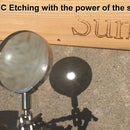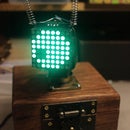Introduction: Low Cost Indoor Pond
I built this pond for my living room in two days. The total cost was less than $200, using common tools and other items available at your local hardware store or home and garden center.
Step 1: Initial Design
Decide where you will put your pond, and how big you want it to be. I chose to make mine 4' X 4'. The actual frame is 16" tall, but the water is only 8" deep, and raised up 8". One thing to consider is that 1 gallon of water weighs about 8 pounds. Here is a link to a good pond calculator. My pond holds about 70 gallons (560 pounds). If you place your pond on an upper level of your house, you should try to place it along a load bearing wall. A larger pond should be placed on the ground floor. Please make sure your floor will be able to hold your pond. Nobody can be held responsible for any catastrophies but you. Do your homework. This link is a good place to start. FYI, a waterbed holds ALOT more water than this!
Step 2: Supplies
Here is a list of supplies I bought for this project:
1 Pond Kit. It includes a pump and a mechanical filter, 3 underwater lights, 12'X 9' pond liner, a little fish that spits water, and 3 different fountain heads. Paid $79 at my local Meijers store. If you plan on adding fish to your pond, you will need a "biofilter" to remove the fish waste. This filter only filters out large particles, not bio-matter.
For the contruction of the pond itself, I bought:
10 8' 2X4's (I had them cut in half at the hardware store so they would fit in my car)
2 pieces of 1/4" plywood, 2'X 4'. You could use one larger piece, but again, I have a small car.
2 pieces of 1/2" pine 4'X 16", for the facing. I only bought 2 because I planned on putting the pond in a corner.
4 pieces of 1/2" poplar 4'X 4" to go around the top.
1 pound of 3 1/4" nails.
2 30 pound bags of river stones. Make sure you get "prewashed or prescreened" stones for pond use. Regular landscaping stones are often very dirty.
Stain and finishing supplies.
Choose the grade of wood according to how you plan on finishing your pond. I chose some good stain grade wood, but you could get cheaper "paint grade" if thats what you plan on doing. All this stuff was from Lowe's. Wood and supplies: $120
Total: $199
Step 3: Initial Construction
I built the frame slightly smaller than 4', actually 3'10", to leave room to mitre cut the 4' facing boards. I then added 5 support beams 8" from the bottom to support the raised plywood bottom. I had a few boards left, so I added a few extra braces where I thought they would help. Then I nailed down the plywood to the bottom braces. I wished I had a chalkline.
Step 4: Putting It in Place.
At this point, the frame is complete, and feels very sturdy. Its not too heavy, since I carried it up the stairs from my garage by myself. I did notice it is not perfectly square, but it should be fine. I used a plaincircular saw to make all the cuts. A table saw would have been better. The first picture shows it in place. I placed an old blanket in it before the liner to protect it from any tears. I would suggest it. Some people recommend using the blue styrofoam board used in building construction. The second photo shows the liner in place and the water starting to go in. Make sure you have extra liner on all sides (you can cut the excess later) when the water goes in, it tends to pull the liner tighter.
Step 5: Filling and Checking for Leaks
Before you fill your pond, make sure you have it EXACTLY where you want it, since it will be almost impossible to move. You'll notice I havent added the facing boards yet. This allowed me to see under the pond to watch for leaks. This is the main reason I chose to raise the bottom off the floor. The last thing you want is for it to leak, damage the floor boards, and cause a collapse. I think I may add some sort of simple "water alarm" to the project in the future. When it was full, I added the pump and the lights. I plugged the whole system into one of those remote power boxes you see around christmas time for christmas lights. It comes with a box that plugs into an outlet and a little keychain remote that powers the whole thing on and off. A two channel setup would be better, so you could switch the lights or fountain independantly, but I didn't have one.
Step 6: Making It Look Nice.
The next step I did, was to cut the liner more precisely to allow the facing to be added. Be careful not to cut off too much, especially where it is bunched up in the corners. The liner should have settled in after the pond was completely full, but I found mine settling down just a bit more after I cut it. I then measured and cut my facing boards, and stained them dark walnut to match the rest of the wood in my living room.
Step 7: Finishing It Up, and End Notes
The picture shows the (partially)finished pond. I made an error in measuring for my top facing boards. I measured them to fit over the frame, but forgot to provide for the extra front facing boards that would be added on the two sides. My top piece ended up being slightly too small. The picture shows the top pieces just laid on top of the pond (you may notice in the picture). I will have to make new ones tomorrow. I added this part hoping you will not make this mistake as well. Also, make sure you use PLENTY of sealer or polyurethane on the facing boards you use. I have found that even if you have the fountain spraying very low, little bits of water will get on it after awhile, even the carpet may get damp from the tiny mist after a few days.
One final note:
I'd like to thank my wife for leaving me, so that I may spend my time doing fun things like this, and enjoying myself fully. :-)
~~Andrew
Participated in the
The Instructables Book Contest













